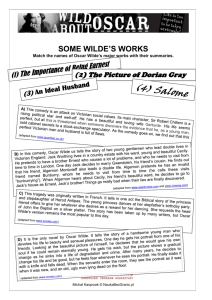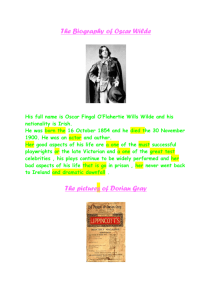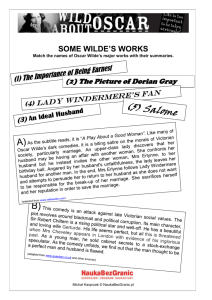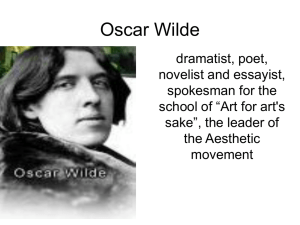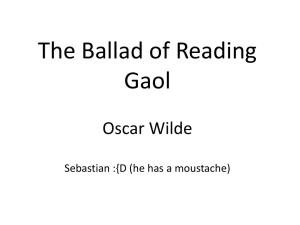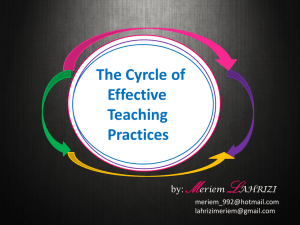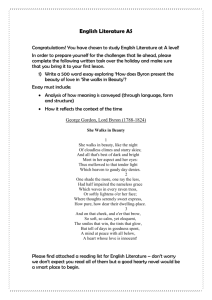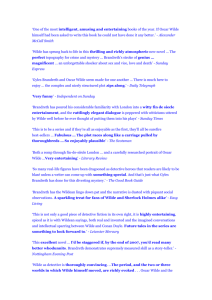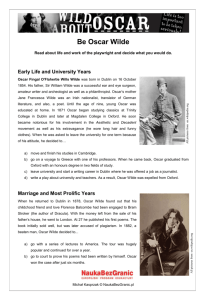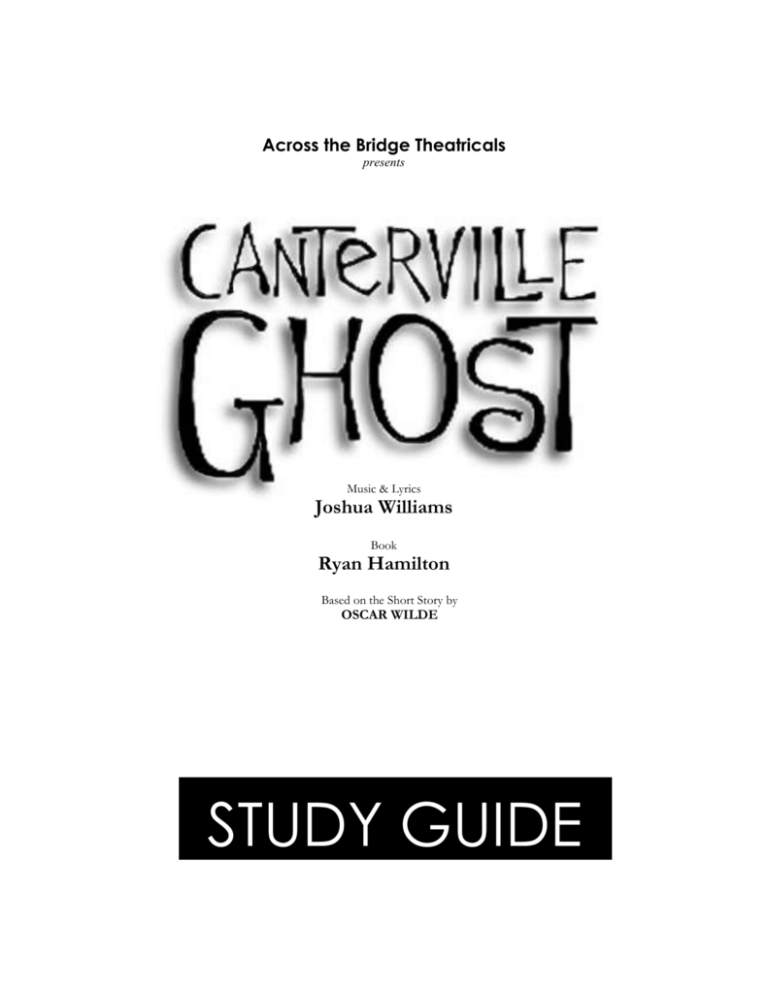
Across the Bridge Theatricals
presents
Music & Lyrics
Joshua Williams
Book
Ryan Hamilton
Based on the Short Story by
OSCAR WILDE
STUDY GUIDE
2
TABLE OF CONTENTS
I.
Forward: Using the Study Guide
II.
Producer’s Corner
III.
About the Authors
IV.
About CANTERVILLE GHOST
i.
A Brief Synopsis
ii.
Cast of Characters
iii.
Musical Numbers
V.
The Life and Times of Oscar Wilde
i.
Biography
ii.
Wilde’s Bon Mots (Oscariana)
iii.
Aesthetic Movement
iv.
Literary Contemporaries of Wilde
VI.
Lesson One: HISTORY
i.
1920s Chronology of Events
ii.
The Roaring ‘20s: What’s Hot?
iii.
Art Deco Movement
iv.
History Exercises
VII.
Lesson Two: LANGUAGE ARTS
i.
An Overview: Tapping into the Modern Wilde
ii.
Language Arts Exercises
VIII.
Lesson Three: MUSIC
i.
An Overview: A Fertile Ground for Creativity
ii.
Music Exercises
iii.
In-Depth: The Demo
IX.
Theatre In Action
i.
Student Critics Program
ii.
Master Classes
iii.
Group Sales
X.
Resources
i.
Books
ii.
Stage
iii.
Music
iv.
Film
v.
Web
3
USING THE STUDY GUIDE
We are pleased to present the first edition of the CANTERVILLE GHOST
Study Guide. CANTERVILLE GHOST is an energetic musical comedy full of
sharp wit, glitz, suspense and drama; it’s also a musical that explores the idea
of rising above our cultural identity and embracing others on a human level. It
affords its audience a chance to be both entertained and educated.
This guide is meant to give educators an added teaching tool, using the
theatre and CANTERVILLE GHOST as a medium to discuss the ideas
presented in the show through history, language, and media studies. This
guide offers background on CANTERVILLE GHOST and its creators, as well
as lesson plans and exercises that encourage critical thinking, discussion and
writing.
As part of the curriculum, the producers of CANTERVILLE GHOST would like
to give select students the opportunity to attend opening night in each city as
press in order to review the show for their student or local newspaper. We
realize the importance of bridging the gap between the classroom and stage.
To participate, please contact your local theatre for more information.
In addition, please check your local theatre for other educational events,
including workshops and master classes presented in conjunction with
CANTERVILLE GHOST. These events offer students the unique opportunity
of interfacing with professional theatre artists and learning first-hand from
some of the best of Broadway talent.
We are excited to make this Study Guide available to you and your students.
We hope it will help you to incorporate CANTERVILLE GHOST into your
classroom.
--ACROSS the BRIDGE THEATRICALS Education Team
© 2004 ATB Theatricals
4
PRODUCER’S CORNER
In 2002, I hired Joshua Williams to be the musical
director on a directing project of mine. In a pinch, we
had to change shows mid-stream and my options
were limited. Knowing Joshua wrote musicals, I
asked if he had anything he’d be interested in having
produced. He mentioned that he was starting a
major rewrite with a new book writer, Ryan Hamilton,
on a musical called CANTERVILLE GHOST. I asked
him if the could have the rewrites done in two weeks.
Two weeks later they handed me the script and we
began rehearsals. Four weeks later we opened with
a bare-bones set, wild costumes, and an energetic
cast.
Across the Bridge Theatricals optioned the rights to
produce CANTERVILLE GHOST in the spring of
2003. We immediately recorded a demo CD under
the talented musical direction of Mary-Mitchell
Campbell. In June 2003, we produced an Equity
staged reading of CANTERVILLE GHOST at the
Manhattan Theatre Club Creative Center for industry
professionals.
Since the reading, the creative team of
CANTERVILLE GHOST has worked tirelessly
on rewrites, marketing and PR initiatives and
fundraising. The October 2005 production at
the SCERA will mark the first full realization of
CANTERVILLE GHOST with fully designed
costumes, sets and sound, along with new
choreography and orchestrations. A visual and
aural feast!
I am excited to be at the helm of this rare breed
of musical that will appeal and connect to
children and adults alike.
I hope that
CANTERVILLE GHOST will spark your imagination the same way it has sparked mine. I
am pleased to present the CANTERVILLE GHOST Study Guide; it offers many different
activities and materials that are sure to bring the performing arts alive in your classroom.
Kevin Monk
Executive Producer
Across the Bridge Theatricals
5
Joshua Williams Music/Lyrics
Joshua Williams began his career in the theatre at a very early
age. His performances and choreography have been featured
on stage and television in America, France, Germany, Poland,
and Japan. In 1993, he was awarded the top national award
for excellence in the arts by President Clinton and performed
at the Kennedy Center for the Performing Arts in Washington
DC. Joshua has written numerous musicals and cabarets
including Songs from Warsaw, Feel the Music, The
Drummings and Canterville Ghost. Joshua’s music was
recently featured at the Brooklyn Film Festival in Annie Poon’s
short animated film, “Runaway Bathtub”.
Joshua received his Bachelor of Arts from Brigham Young
University in Theatre Arts with an emphasis in playwriting and
directing. He recently relocated from New York City to
Philadelphia where he lives with his wife Katie and his
daughters Madeleine and Maja.
ABOUT THE AUTHORS
Ryan Hamilton Book
Executive Producer
Kevin Monk
Across the Bridge Theatricals
Music Supervisor & Additional Music
Tom Jensen
Orchestrations
Jeremy Lenz
Graphic Design
Tomasz Okreglicki
Ryan is a writer, humorist, and stand-up comedian. Although
Canterville Ghost is his first foray into musical comedy, he has
previously written plays, screenplays, sketch comedy, humor
columns, and short essays. His work has been published in
various local and regional publications, as well as on several
websites, including The White Shoe Irregular (www.whiteshoe.org)
and Bit and Bitter: The Workplace Alternative to Solitaire
(www.bitandbitter.org). Ryan spent several years as a writer,
performer and president in the sketch comedy troupe Divine
Comedy (www.divinecomedy.net).
Ryan holds a Bachelor’s Degree from Brigham Young University in
Applied Physics, with a minor in Mathematics. He currently resides
in Chicago where he is working on a Masters Degree in Marketing
at Northwestern University.
A SYNOPSIS
6
CANTERVILLE GHOST is a musical based on the Oscar Wilde
novella by the same name. Set in the 1920s, it is the tale of a young
American family moving into a medieval English manor haunted by a fine
and respectable ghost of the grand tradition; an expert performer and
master of his craft. Unfortunately for the ghost, modern American
sensibility leaves little room for such nonsense as haunting.
The story maintains the subtle wit and dry humor of the Wilde original,
while adding a musical score with more than twenty original songs. It plays
liberally with American and British customs, politics, and age-old
stereotypes, lambasting both countries to riotous effect.
ACT ONE
The Hiram and Lucretia Otis family is a good upstanding and very patriotic American family.
Washington, their oldest son, has just returned from a stint in the army. Virginia, a charming girl,
is fifteen going on sixteen. Lewis and Clark are the conniving nine-year old twins. They enjoy the
comforts of life and the best of society in decadent 1920s New York where Art Deco skyscrapers
and jazz music is all the rage. That is, until their lives are turned upside down by a surprise call
from their father, who is in England on business. “We’re moving to England!” The family scurries
off to pack, leaving Virginia alone to wonder about the big move all the way across the ocean
(“I’m Leaving Home”). Oscar and his fellow ghosts have been stuck in limbo. Four hundred
years ago their master, Sir Simon, killed his wife. Now all of his former servants are cursed to
haunt the Canterville Chase until Sir Simon is forgiven by a young innocent girl. Boredom has set
in as the ghosts must continue to haunt year after year to no avail (“The Curse of Sir Simon”).
When Oscar learns that the new tenants will be Americans he devises a plan in which he will
disguise himself as the maid, Mrs. Umney (“Our Little Charade”). Upon arriving at the Chase,
the Otis family is welcomed by Mrs. Umney and the “ghosts”. They immediately notice Virginia.
(“The Promise I”). The family is thoroughly nonplussed by the tale of a haunted house, but they
don’t take too kindly to the bloodstain on the parlor rug (“Out Damn Spot”). Upon the successful
removal of the bloodstain, Lord Canterville and his nephew, Cecil, arrive to meet their new
tenants. Cecil is immediately smitten with Virginia (“The Promise I”). Virginia is the key to the
ghosts’ redemption if they can only get her to forgive Sir Simon, who is busy planning his latest
haunting campaign (“Keeping up the Appearances”). Virginia is getting ready for bed. She
asks Mrs. Umney about the Canterville Chase after she notices the etching in the fireplace
mantel. Mrs. Umney explains the curse (“The Promise II”) and turns out the light. Cecil, unable
to hold off one minute longer, has found a way to climb into Virginia’s bedroom in hopes of
winning her heart. Virginia tells him all about herself (“Anything”). Upon hearing the ruckus in
Virginia’s room, Mr. and Mrs. Otis invite Cecil to leave. He laments (“When You’re Fifteen”).
Sir Simon, as usual, begins his haunting routine. He is completely taken aback when his first
victim, Virginia, replies to his chain rattling completely unabashed. He rushes off to his cellar in
an embarrassed rage. With a little research he wonders out loud to Oscar if Virginia’s lack of
respect is due to the fact that she is American (“They Won’t Dare”). Oscar sees his chance for
freedom by pitting Sir Simon against the Otis family in a series of daring haunts (“Scare Suite”).
Much to Oscar’s glee, Sir Simon is a miserable failure. He has only managed to irritate the Otis
Family. Now, if he can only rouse Sir Simon’s pride and supply the perfect costume for one last
7
big hurrah, his plan should work. Meanwhile, Mr. Otis is tired and Washington is mystified by the
yellow bloodstain in the parlor (“Four Hundred Years”).
ACT TWO
Sir Simon seems to have gained some ground. Mr. Otis is thoroughly tired, unable to sleep due
to Sir Simon’s terrible rasping and moaning. And the bloodstain has changed colors again—
green. There must be a better way to take care of this “ghost” situation. He calls his family
together for a meeting (“Take the Prize”). Virginia, horrified by the “capital” idea the family
hatches to “catch the ghost” leaves the room.
Washington and the twins plan their next
CAST OF CHARACTERS
move.
Mrs. Otis, always meticulously
The Ghosts
focused, is planning a welcome party. Sir
Oscar/Mrs. Umney
Simon, in his cellar, muses over his fate and
Former Maid
his inability to scare (“Keeping up
Former Cook
Appearances reprise”). Virginia has found
Former Gardner
some solace from her family in the Chase’s
Former Priest
garden. She is quickly found by Mrs. Umney,
elated that with Virginia upset, her plan is
Otis Family
progressing nicely. She leaves Virginia with a
Mrs. Lucretia Otis
Mr. Hiram B. Otis
letter from Cecil (“That’s How I’ll Know”).
Washington Otis
Sir Simon has reached the end of his rope, he
Virginia Otis
has been given notice to leave the premises
Lewis Otis
or be charged rent. It’s all out war now (“A
Clark Otis
Model Man”), until Sir Simon is scared
witless by the twins’ pretend ghost set up in
The Cantervilles
the parlor. In the meantime, the spot is now
Lord Canterville
pink, much to Washington’s dismay, and Cecil
Duke Cecil Canterville (the Lord’s nephew)
is making plans to propose marriage to
The Canterville Ghosts
Virginia (“The Promise III”). Sir Simon has
Sir Simon de Canterville
decided, at the suggestion of Oscar, to speak
Eleanor de Canterville (Sir Simon’s wife)
with this new ghost in hopes of joining forces
(“When You’re Fifteen reprise”). He soon
The Chorus the townspeople of Ascot, England and
realizes he has been foiled again—the ghost
the ghosts of the past.
is a fake. Oscar is quite pleased with himself
as he prepares for Mrs. Otis’ big party (“Our Dismal Charade reprise”). The guests are arriving
and Mr. Otis is proud of his Americanized Chase. The guests begin to arrive and the past and
present meet (“The Masked Waltz”). Washington decides to get the party going with a rousing
and jazzy swing (“Movin’ It”). Cecil has lost no time in securing a dance with Virginia and then
manages to convince Virginia to steal away with him to her room. Virginia, a little excited and
scared, wonders if maybe she should rejoin the party, but Cecil insists she stay with him
(“Love”). Sir Simon has had enough, he can wait no longer; he will steal Virginia away from her
family, maybe that will teach them a lesson (“Without Wings”). Virginia has disappeared right
before Cecil’s eyes. Her parents are deathly afraid for her safety as Mrs. Umney tries to hide her
obvious delight with worry. They put together a search party. Virginia, managing to stay
composed, realizes Sir Simon’s desperation. She shows the ghost pity, but he resists her. The
search for Virginia continues. Sir Simon is sure he is incapable of being forgiven. He tells his
story to Virginia who begins to weep, fulfilling the promise. Virginia holds Sir Simon’s hand and
tells him he must now ask Eleanor, his wife, for forgiveness (“Fly Away”). Eleanor accepts him
and they disappear into a bright light leaving Virginia all alone. Virginia realizes that somehow life
has changed forever (“That’s How I’ll Know reprise”). In a burst of color and light, Virginia is
back in the parlor where her family finds her. The curse is broken. At Sir Simon’s funeral, Lord
Canterville offers Eleanor’s pearl necklace as a thank you for fulfilling the promise. Cecil beams
with pride; Virginia has agreed to be his girlfriend. Mrs. Umney and the ghosts, unable to resist,
reveal their true identities to the surprise of all the guests. And without any further adieu, they pull
out all the stops for a rousing farewell to their former master, Sir Simon. Although Oscar makes
sure he gets the last hurrah with a ride to heaven on a shiny star (“Take Him Home”).
8
MUSICAL
NUMBERS
ACT ONE
I’m Leaving Home
The Curse of Sir Simon
Our Little Charade
The Promise I
Out Damn Spot!
The Promise I
Keeping up Appearances
The Promise II
Anything
When You’re Fifteen
They Won’t Dare
Scare Suite
Four Hundred Years
Virginia
Oscar, Sir Simon, The Ghosts
Oscar, The Ghosts
The Ghosts/Chorus
Washington, Mrs. Umney, Otis Family
The Ghosts/Chorus
Sir Simon, Oscar, The Ghosts
The Ghosts/Chorus
Virginia, Cecil
Virginia, Cecil
Sir Simon, Oscar
Instrumental
Oscar, Sir Simon, The Ghosts/Chorus, Otis Family
ACT TWO
Take the Prize
Mr. Otis, Mrs. Umney, Otis Family
Keeping up Appearances rep Sir Simon
That’s How I’ll Know
Virginia, The Chorus
A Model Man
Oscar, Sir Simon
The Promise III
The Ghosts/Chorus
When You’re Fifteen rep
Sir Simon
Our Little Charade rep
Oscar
The Masked Waltz
Company
Movin’ It
Washington, Cecil & Company
Love?
Cecil, Virginia
Without Wings
Sir Simon, The Ghosts/Chorus
Fly Away
Virginia, Sir Simon, Eleanor, The Chorus
That’s How I’ll Know rep
Virginia, The Chorus
The Promise IV
The Ghosts/Chorus
Finale—Take Him Home
Oscar & Company
9
OSCAR WILDE (1854-1900)
Oscar Wilde was born in 1854 and grew up in an intellectually bustling Irish household. His mother, Jane
Francesca Elgee Wilde, was a poet who wrote under the pen name Speranza and who had a considerable
following; his father, Sir William Wilde, was a renowned physician with an interest in myths and folklore.
At Oxford he won a coveted poetry award and came under the influence of the late nineteenth century
aesthetic movement. He found its notions of "art for art's sake" and dedicating one's life to art suitable to
his temperament and talents. Oscar had a desire to make himself famous and set off to London to do just
that.
From 1878 to 1881 Oscar Wilde became well known for
being well known despite having any substantial
achievements to build on. He insinuated himself into the
class of people he labeled as "the beautiful people", wore
outrageous clothes, passed himself off as an art critic and
aesthete, and built a reputation for saying shocking things
and doing amusing ones. If one tells the truth, one is sure
sooner or later to be found out. His natural wit and good
humor endeared him to the art and theater world and
through his lover Frank Miles he found easy entry into the
cliques that frequented London's theater circuit and
drawing rooms.
He became a much-desired all-purpose party guest and,
with his velvet coat, knee breeches, silk stockings, pale
green tie, cane, shoulder-length hair, loose silk shirts and
the lily he occasionally carried through Piccadilly Circus,
much talked about and satirized. His popularity and
flamboyance led to his being chosen as an advance
publicity man for a new Gilbert and Sullivan operetta,
Patience, that spoofed aesthetes like himself, and which
paid him one third of the box office receipts.
In 1882 he arrived in New York City and began a year long tour of North America. When a customs
inspector asked him if he had anything to declare he replied, "Nothing but my genius." At 28 he lectured in
70 American cities on the arts and literature. His performances were as wildly popular as his audiences
were varied: he spoke to Mormons in Salt Lake City, silver miners in Colorado, West Coast literati in San
Francisco, farmers in Kansas, and swung through Ontario and Quebec.
When he returned from America he had tired of being the Great Aesthete and returned to more
conventional dress. He toured, wrote two unsuccessful plays and a well received collection of children's
fairy tales, married, fathered two sons and took a position as editor of Woman's World, a monthly magazine
for which he wrote literary criticism.
Two years later he tired of journalism and journalists and returned to sparkling at parties and spending
much of his time with friends and lovers, often stepping beyond the bounds of what was considered
morally and socially proper for the time. In 1884, he married Constance Lloyd, the daughter of a Dublin
barrister and a woman with financial resources. They moved into a home in the Chelsea section of London.
From 1890 to 1895 Oscar Wilde reached the peak of his career, both as poet-playwright and social gadfly.
His novel, The Picture of Dorian Gray raised a storm of indignation to thinly veiled allusions to the
protagonist's homosexuality. In the same year he came out with a well received volume of children's
stories, Lord Arthur Savile’s Crime, and other Stories (includes Canterville Ghost), The House of
Pomegranates and followed with a succession of enormously successful plays that reintroduced the
comedy of manners to the English Stage: Lady Windermere's Fan, A Woman of No Importance, An Ideal
10
Husband and The Importance of Being Ernest, the latter being hailed as the first modern comedy in
English. In 1892, he wrote Salome, which wasn’t performed until 1894 by renowned actress Sarah
Bernhardt in Paris.
Wilde's plays served as a catalyst in creating the modern era. Collectively they "forced Victorian society to
re-examine its hypocrisies and delineated with wit and humor, the arbitrariness of many moral and social
taboos which, to the unreflective Victorian eye, appeared to be eternal.
In 1895 the eighth Marquess of Queensberry,
considered quite mad by even members of his
immediate family, culminated his persistent public
harassment of Wilde for his off-and-on sexual
relationship with his son Lord Alfred Douglas. A
libel suit filed by Wilde against the Marquess
backfired; the Marquees was acquitted and Wilde's
not too well camouflaged desire for men landed
him two years of hard labor. Wilde resisted the
urgings of his friends to leave for the Continent,
where a more tolerant sexual mores prevailed,
saying he should accept with dignity the
consequences of his actions. The supreme vice is
shallowness.
While in prison he wrote a 30,000 word letter to
Douglas, published after his death with the title De
Profundis, that is regarded as possibly being his
most important and mature statement on life and art
in general and his own life and art in particular. In
concluding, he tells Douglas, "You came to me to
learn the Pleasures of Life and the Pleasures of Art.
Perhaps I am chosen to teach you something much
more wonderful, the meaning of Sorrow, and its
beauty."
After his release from prison, Wilde left England and wandered around Europe for the last three years of
his life using the alias Sebastian Melmoth. He was a broken man who sank deeper into a reckless life of sex
and absinthe which neither he nor long-time friends could extricate him. His one noteworthy piece from
this period is The Ballad of Reading Gaol, a gripping account of prison brutality based on his own
harrowing experiences with a plea for prison reform.
He endured his final days in poor health and living on borrowed money and the kindness of sympathetic
friends and hotel managers. In 1900, in Hotel d'Alsace in Paris, he died of cerebral meningitis after being
baptized into the Roman Catholic Church. He is buried at Bageaux.
And alien tears will fill for him
Pity's long broken urn
For his mourners will be outcast men
And outcasts always mourn
Picture and text adapted from:
http://www.geocities.com/TelevisionCity/8889/wilde.htm
11
Wilde’s Bon Mots
In matters of grave importance, style, not sincerity,
is the vital thing.
The Importance of Being Earnest, 1895
There is only one thing in the world worse than
being talked about and that is not being talked
about.
Picture of Dorian Gray, 1891
It is only shallow people who do not judge by
appearances.
Picture of Dorian Gray, 1891
In this world, there are two tragedies. One is not
getting what one wants, and the other is getting it.
Experience is the name everyone gives to their
mistakes.
Lady Windermere’s Fan, 1892
There is no sin except stupidity.
We have really everything in common with America
nowadays except, of course, language.
The Canterville Ghost, 1882
The only thing to do with good advice is pass it on.
It is never any use to oneself.
We are all in the gutter, but some of us are looking
at the stars.
Lady Windermere’s Fan, 1892
One can survive everything, nowadays, except
death, and live down everything except a good
reputation.
The truth is rarely pure and never simple.
The Importance of Being Earnest, 1895
The public is wonderfully tolerant.
everything except genius.
The Critic as Artist, 1891
It forgives
The only duty we owe to history is to rewrite it.
A thing is not necessarily true because a man dies
for it.
Fashion is a form of ugliness so intolerable that we
have to alter it every six months.
Consistency is the last refuge of the imaginative.
Resources:
http://www.geocities.com/TelevisionCity/8889/wilde.htm
www.quotationpage.com
12
AESTHETIC MOVEMENT
The Aesthetic Movement is a loosely defined movement in art and literature in later nineteenth
century Britain. Generally speaking, it represents the same tendencies that Symbolism or
Decadence stood for in France, and may be considered the English branch of the same
movement. It belongs to the anti-Victorian reaction and had post-Romantic roots. It took place in
the late Victorian period from around 1868 to 1901, and is generally considered to have ended
with the trial of Oscar Wilde.
Wilde’s Contemporaries in Great Britain:
The English decadent writers were deeply
influenced by Walter Pater and his essays published
in 1867-1868, in which he stated that life had to be
lived intensely, following an ideal of beauty.
Decadent writers used the slogan, coined by the
philosopher Victor Cousin and promoted by
Theophile Gautier in France, “Art for Art’s Sake”
(L’art pour l’art) and asserted that there was no
connection between art and morality.
Bram Abraham Stoker (1847-1912)
Frankenstein
Arthur Conan Doyle (1859-1930)
Sherlock Holmes
Robert Louis Stevenson (1850-1894)
Strange Case of Dr. Jekyll & Mr. Hyde
Joseph Conrad (1857-1924)
Heart of Darkness
George Bernard Shaw (1856-1950)
Pygmalion
W.S. Gilbert (1836-1911)
The Mikado
The artists and writers of the Aesthetic Movement
tended to hold that the Arts should provide refined
sensuous pleasure, rather than convey moral or
sentimental messages. As a consequence, they did not accept John Ruskin and Matthew
Arnold’s utilitarian conception of art as something moral or useful. Instead they believed that Art
does not have any didactic purpose, it need only be beautiful. The Aesthetes developed the cult
of beauty which they considered the basic factor in art. Life should copy Art, they asserted. The
main characteristics of the movement were: suggestion
Wilde’s Contemporaries in America:
rather than statement, sensuality, massive use of symbols,
and synaesthetic effects—that is, correspondence between
Stephen Crane (1871-1900)
words, colors, and music.
The Red Badge of Courage
Frances Hodgson Burnett (1849-1924)
The Secret Garden
Henry James (1843-1916)
Daisy Miller
Edith Wharton (1862-1937)
Age of Innocence
Mark Twain (1835-1910)
Tom Sawyer
Aestheticism had its forerunners in John Keats and Percy
Bysshe Shelley, and among Pre-Raphaelites. In Britain the
best representatives were Oscar Wilde and Algernon
Charles Swinburne, both influenced by the French
Symbolists.
Artists associated with the Aesthetic
Movement include James McNeill Whistler and Dante
Gabriel Rossetti. Writers include Oscar Wilde. The
movement had an
Wilde’s Contemporaries Elsewhere:
influence on interior design. ‘Aesthetic’ interiors were
characterized by the use of such things as peacock
Henrik Ibsen (Norway, 1828-1906)
feathers and blue-and-white china. This aspect of the
A Doll’s House
movement was satirized in Punch magazine, and in Gilbert
Henryk Sienkiewicz (Poland, 1846-1916)
and Sullivan’s operetta Patience.
Quo Vadis
Leo Tolstoy (Russia, 1828-1910)
Anna Karenina
This text quoted directly from:
http://en.wikipedia.org/wiki/Aesthetic_movement
(GNU Free Documentation License)
13
1920s CHRONOLOGY OF EVENTS
1920
Prohibition: 18th Amendment to the Constitution
Bubonic Plague in India
First Commercial Radio Broadcast Aired
Harlem Renaissance Begins
League of Nations Established
Pancho Villa Surrenders
Women Granted the Right to Vote in U.S.
Warren Harding elected president
19th Amendment grants women's suffrage
1922
Kemal Atatürk Founds Modern Turkey
King Tut's Tomb Found
Michael Collins Killed in Ambush
Mussolini Marches on Rome
The Reader's Digest Published
Sinclair Lewis writes Babbitt
1924
1926
1928
First Olympic Winter Games
J. Edgar Hoover Appointed FBI Director
Leopold and Loeb Murder a Neighbor
Out of Boredom
V.I. Lenin Dies
A.A. Milne Publishes Winnie-the-Pooh
Houdini Dies After Being Punched
Robert Goddard Fires His First
Liquid-Fuel Rocket
A Woman Swims the English Channel
Bubble Gum Invented
First Academy Awards
First Mickey Mouse Cartoon
First Oxford English Dictionary Published
Kellogg-Briand Treaty Outlaws War
Penicillin Discovered
Hoover elected president
1921
"Fatty" Arbuckle Scandal
Extreme Inflation in Germany
Irish Free State Proclaimed
Lie Detector Invented
Congress enacts immigration quotas
Washington Naval Conference
1923
Charleston Dance Becomes Popular
Hitler Jailed After Failed Coup
Talking Movies Invented
Teapot Dome Scandal
Time Magazine Founded
Harding dies, succeeded by Coolidge
1925
Flapper Dresses in Style
Hitler Publishes Mein Kampf
The Scopes (Monkey) Trial
(Tennessee Evolution trial)
1927
Babe Ruth Makes Home-Run Record (60)
BBC Founded
The First Talking Movie, The Jazz Singer
Lindbergh Flies Solo Across the Atlantic
Sacco and Venzetti Executed
1929
Byrd and Bennett Fly Over South Pole
Car Radio Invented
New York Stock Market Crashes
St. Valentine's Day Massacre
Resource: www.about.com
14
Price of 1-gallon of Milk
$.58
U.S. Population
122 million
Children's Toys
Baby Doll that says “mama”
Average Annual Income
Paper Dolls
$1,574
Teddy Bears
Metal Trucks
Popular Children’s Books
Cultural Crazes
Tinker Toys
“Winnie the Pooh”
Marathon Dancing
Erector Sets Fashion
“Bambi”
Charleston
Erte
“Dr. Doolittle”
Mahjongg
The Bob
“Velveteen Rabbit”
Flag Pole Sitting
Short Hemlines
Ouija board
Favorite Cartoon Characters
Cloche Hats
Crossword Puzzles
Mickey Mouse
Knickers
New Foods
Little Orphan Annie
Leather Jackets
Welch's Grape Jelly
Felix Cat
Raccoon Coats
Wrigley's chewing gum
Eskimo pie
Famous People
Amelia Earhart
Gertrude Ederle
Famous Artists
Annie Oakley
Pablo Picasso
Albert Einstein
Wassily Kandinsky
Al Capone
Popular Composers/Lyricists
Salvador Dali
Harry Houdini
Duke Ellington
George Gershwin
Will Rogers
Cole Porter
Favorite Songs
Richard Rogers
“It Had to Be You”
Lorenz Hart
“Stardust”
Oscar Hammerstein II
“Swanee”
“Rhapsody in Blue”
Innovations
“I Got Rhythm”
Model A
“Let’s Misbehave”
Band-Aids
“Singin’ in the Rain”
Kleenex
Favorite Sports
Penicillin
Popular Children's Games
Tennis
Zippers
Marbles
Golf
“Talkies” (movies with sound)
Jump Rope
Baseball
Roller Skates
Popular Movies
Football (college)
Statue
“The Jazz Singer”
“Treasure Island”
“Ben Hur”
Favorite Actors
On Broadway
“Ziegfield Follies”
“No, No Nanette” 1925
“Showboat” 1927
“Lady Be Good”
Rudolph Valentino
Clara Bow
Mary Pickford
Douglas Fairbanks
Al Jolson
Charles Chaplin
Buster Keaton
Gloria Swanson
Sports Heroes
Babe Ruth
Jack Dempsey
Popular Writers & Books
Ernest Hemingway Farewell to Arms
F. Scott Fitzgerald The Great Gatsby
Langston Hughes (poet)
Edna St. Vincent Millay (poet)
Edith Wharton Age of Innocence
Main Resource:
http://www.geocities.com/MotorCity/Lane/6341/History/stats.html
15
ART DECO MOVEMENT
The period termed "art deco" manifested itself roughly between the two world wars, or
1920 to 1939. During the years when Art Deco as a style was in fashion the term Art
Deco was not known. Modernistic or Style Moderne was used. The term was coined in
the 60's by Bevis Hillier, a British art critic and historian. The name Art Deco was derived
from the 1925 Exposition Internationale des Arts Decoratifs Industriels et Modernes, held
in Paris. Art Deco is widely used in many areas as a decoration style, such as
architecture, interiors, furnishing, fine arts, handmade crafts, posters, and industrial
design. If one is looking for an appropriate word to describe overall Art Deco as a design
style, 'Speed' would be the best word for it. "During the Great Depression, a second Art
Deco period, buildings usually have very little ornamentation and have a very flat,
machine-like look" (2). In fact, Art Deco was influenced by the modern art movements of
Cubism, Futurism, and Constructivism; however, it also took some ideas from the
ancient geometrical design styles, such as Egypt, Assyria and Persia. Art Deco
designers use stepped forms, rounded corners, triple-striped decorative elements and
black decoration. Most importantly, they are all in geometrical order and simple formats.
With the increasing of machine power, Art Deco also used machine-like materials.
Pictures & Text Adapted from:
1. http://www.retropolis.net/history.html
2. Klunk, Melissa. "Art Deco: Americans Last National Style."
http://floridastory.com/deco.htm (12 Nov 2000)
3. www.greatbuildings.com
16
HISTORY EXERCISES
Discussion:
1. Oscar Wilde died a lone man in 1901. Do you think his ideas would have been
more accepted in the 1920s? In what ways were Wilde’s ideas and artistic goals
“ahead of his time”? How do you think Wilde would fit into today’s society?
2. Oscar Wilde is famous for his one-line quotes, which he often debuted in
conversation. What sort of individual do you think Wilde would be based on
these quotes? Why are the quotes still timely today?
3. The 1920s represented a major shift in technology. How do you think these
changes affected society? How did they affect America’s role in the international
community? How did they change the role of women in society? How did these
changes affect the stock market?
4. Prohibition is often synonymous with the “Roaring ‘20s”. What do you think led to
Prohibition? How did Prohibition affect American culture? How do you think
other cultures viewed America under prohibition? How has Prohibition
permeated today’s culture?
Individual Activities:
1. Pick a name from the “What’s Hot” section. Find an art piece, book, composition,
etc. that was created by one of these people and study it, read it, or listen to it.
2. Imagine that you were a young person just arriving in New York City in the
1920s. Write a letter back home describing what you may see or experience.
3. Find something in your home that may have been created in the 1920s. List the
things that define it as an object from this time period. Then choose an item that
is current. Re-design this object to fit the style of the 1920s.
Group Activities:
1. Choose an event from the 1920s chronology. As a group, research the event.
Find out what caused the event and what the repercussions of the event were.
Prepare a short presentation for your class with the information you find.
2. Create a piece of art that would fit the Art Deco movement of the 1920s. Discuss
as a group if your piece of art would fit the tenets of the Aesthetic Movement.
Present your art to the class.
3. Create a scene for play set in the 1920s. Base your scene on an event from the
1920s chronology. Use 3 of Oscar Wilde’s quotes in your scene.
17
LANGUAGE ARTS OVERVIEW
Tapping into the Modern Wilde
Adapting a piece of literature for the stage can be daunting, especially when that work is
by Oscar Wilde, master of wit and language. Add to that the peculiarities of Victorian
fiction and the Aesthetic Movement which both often left believability and reality by the
wayside opting instead for whimsy and colorful characters to make a strong thematic or
moral statement, and the adaptor’s task becomes very difficult indeed. Although with
Wilde, nothing is only surface deep or perfectly moralistic; his effortless writing and
overly simple plots are often only the camouflage of complex ideas and nuanced
characters. This uncanny ability is the reason for Wilde’s enduring popularity and the
reason we chose to adapt CANTERVILLE GHOST in the first place. While certainly a
fairy tale, CANTERVILLE GHOST is also audaciously political as well as spiritual and
philosophical. It’s why the show appeals to children and adults; something we wanted to
keep intact. We had to find ways to keep the Wilde spirit alive and “fill in the blanks” to
make the plot and characters believable to a modern-day audience.
One of the first decisions we had to make when adapting CANTERVILLE GHOST into a
musical was whether or not to keep the story in its original setting, the late 1800s. At
first, we entertained the idea of setting the story in the “present”. All too quickly we
realized that doing this would only date itself more quickly. Our society changes too
swiftly—the technology of a cell phone could be clunky and laughable ten years from
now, something that would only disrupt our telling of the story. And yet we wanted to tap
into an era that felt more modern and accessible. After some discussion and a good
amount of trial and error, it was decided to reset the story in the 1920s. The “Roaring
‘20s” offered a simple solution—a decade of change, progress and modernity trapped in
time! It gave us the framework to “fill in the blanks” and expand a short story into a two
hour musical.
Musically, we didn’t want to be tied down by one particular style. The score was already
shaping up to be an eclectic mix of pop and jazz music with classical overtones. With
our decision to set the show in the ‘20s, the jazz suddenly felt at home in the “jazz age”,
the pop suggested the modern-ness we were aiming for, and the classical evoked
Gilbert & Sullivan, contemporaries of Wilde. It seemed that we had covered all our
bases while staying true to the telling of the story.
Visually, the 1920s represented a vibrant period of American design and technology.
America was having fun and flaunting its success to the world after World War I. Art
Deco skyscrapers were dominating the New York skyline and airplanes made Europe
suddenly accessible to Americans. It was easier to compare cultures in person—a
perfect setting to explore Wilde’s comparison of British and American acumen and
culture.
The final link to adapting the story came with adding a new character to Wilde’s already
colorful cast. We needed to create a friend and foil to Sir Simon de Canterville and the
Otis Family, someone connected to the past and present able to set the plot in motion.
We also needed a character that would add to the physical humor of the world we were
creating, something that would translate well on stage. From these needs, Oscar was
born. This character, based on Oscar Wilde and his mythical status, gave us another
18
way to tap into Wilde’s wry humor. Oscar is a true aesthetic—a man of fashion and
style, a man with progressive ideas, a man stifled by societal mores—much like Wilde
himself.
With these elements in place, the story made the jump from page to stage. After many
different reincarnations and countless drafts, we hope CANTERVILLE GHOST, the
musical, is a successful example of adaptation—fresh and new and still true to its
original spirit.
LANGUAGE ARTS EXERCISES
Discussion:
1. What problems did the authors face in adapting CANTERVILLE GHOST from a
short story to a musical? How were the authors able to overcome these
problems?
2. The authors chose to reset CANTERVILLE GHOST in the 1920s. What were
some of the reasons they gave for doing this? Imagine the story set in another
period. Find reasons why this time period may or may not work.
3. Why did the authors choose to add another character to CANTERVILLE
GHOST? Based on Oscar Wilde’s biography, what sorts of characteristics or
traits would you expect Oscar to have? What types of things would Oscar do or
say in the musical?
4. In what ways is the Aesthetic Movement visible in Oscar Wilde’s writing? What
problems do the tenets of this movement create in adapting CANTERVILLE
GHOST into a play? Do the tenets of the Aesthetic Movement and Victorian
principles compete against each other?
Individual Activities:
1. CANTERVILLE GHOST was one of many stories in “Lord Arthur Saville’s Crime,
and Other Stories”. Choose another of these stories and adapt it or an element
of it into a short scene or play.
2. Write a treatment for a play based on a story or book of your choice. A treatment
includes character descriptions, and a short scene-by-scene breakdown, with
emphasis on important plot points.
3. Choose a story and re-imagine it as a play. Write a short teaser or summary
meant to entice someone to see your play.
Group Activities:
1. Read the short story CANTERVILLE GHOST as a group. Write down the names
of each character in the play and their personal traits. Discuss which traits are
obvious and those that may be ambiguous. Why did Oscar Wilde choose to
focus on some traits and not others?
2. Read the short story CANTERVILLE GHOST as a group. Write down the plot
points (each of the major actions in the story). What holes exist in the plot?
What explanations are lacking in the character’s motives? How would you “fill in
the blanks”?
3. Oscar Wilde is noted for his witty remarks and one-liners. As a group see if you
can create your own. Look for ways to create double entendres (an expression
or term liable to have more than one interpretation). Share these lines with the
class.
19
MUSIC OVERVIEW
A Fertile Ground for Creativity
The most important consideration to make when writing a musical is whether or not the
source material can be set to or enhanced by music. Technically you could probably sing
the phone book, but that would hardly be worthwhile! A composer is looking for
characters with conflict and a story in which music can develop the action, or plot.
Musicals, by their very nature, tend to be bigger in terms of passion and ideas than a
straight play, because music augments emotion. It is necessary then to find a story that
is larger-than-life, or a story that benefits from such an interpretation.
Choosing to adapt CANTERVILLE GHOST as a musical was easy. Oscar Wilde himself
was a larger-than-life individual, not to mention his stories and plays. Fanciful and
colorful, his stories lend themselves effortlessly to music. What’s more, the plot holes
that caused difficulty in writing the libretto were perfect opportunities for composing
songs. Inner-thought and emotion can easily be expressed through music. Finally,
CANTERVILLE GHOST is story about ghosts—a perfect world to infuse with music!
The first step in creating the score for CANTERVILLE GHOST was to find musical ideas
that expressed each character. Some of these ideas carried into the score, turning into
actual songs. A good example of this is “The Promise”. Based on the poem found in the
short story, the musical theme that became the poem’s setting shows up repeatedly in
the musical and within other songs. It’s a theme that suggests innocence in the
protagonist, Virginia, and melancholy in the antagonist, Sir Simon.
Another example of a musical theme that turned into a song was “The Masked Waltz”.
Written in the meters 5/4 and 3/4, the song whirls back and forth between an odd, offkilter meter into a traditional waltz. The 5/4 section was based on a theme that evoked
the death of Sir Simon’s wife Eleanor. Its frenzied pacing also became the genesis for
incorporating a masquerade ball into the show. The 3/4 section is more stately and calls
to mind a fancy ball or dinner. Combining the two as part of one song created both
ambience and a wonderful dichotomy in Sir Simon’s character—calm and feral.
The second step in creating the score to CANTERVILLE GHOST was to find moments in
the story that music could help “push along the plot”. These songs are less about
character and more about action. Oftentimes, music can express action more quickly or
dramatically than doing it in real time.
One of the first action songs written for this show was “Out Damn Spot”. The Otis family
has just arrived at the Canterville Chase when they notice the unsightly bloodstain on
their parlor rug; it must be removed immediately! “Out Damn Spot” quite literally
becomes the “get the stain out” song and heightens the comedy inherent in this action.
At the same time, it introduces information about Sir Simon’s hand in Eleanor’s death.
Whether to develop character or action, music is very powerful. Each melodic or
rhythmic motif has the power to suggest far more than mere words or movement.
Combine them and you start to realize the power of the musical. For that reason, it’s
important for the composer to be in tune with every element of the story.
20
Over 40 songs were written for the show, many of which have been cut. Themes have
been twisted and morphed into new songs. Complete lyrics have been substituted for
new ones. All of it fine tuning. CANTERVILLE GHOST has been a “work in progress” for
many years, changing and growing into a full-fledged musical, but has proven itself a
fertile ground for musical creativity.
MUSIC EXERCISES
Discussion:
1. What does the author suggest is the most important consideration in adapting a
story into a musical? Come up with stories from books, plays or films you’ve
seen that might make a good musical. Discuss why.
2. The composer started out writing theme music for each character. What type of
traits, both physical and emotional would you look for? How are these traits
translated into music?
3. Songs that are sung by one character (monologue) often delve deeper than
dialogue can. Discuss how pop music may do the same. Give examples.
(These pop songs may also have music videos. What do these visual images
represent?)
4. An action song helps “push the plot”. Think of recent films or television shows
you have viewed? Do they have an action song? (Another variation of an action
song is a montage scene, wherein many scenes are shown within the length of
one song.) In what ways might these action songs from films and TV differ from
a musical? How are they the same?
Individual Activities:
1. Create a short lyric that says something about you, or describes an emotion that
you may feel. Try to set it to music by humming or using an instrument.
2. Watch your favorite film. See if you can identify each main character’s musical
theme.
3. Find a favorite song. Create a scene or montage using this song as your guide.
Group Activities:
1. Gather together instruments. Have two group members perform a scene while
the rest of the group plays music as underscore. How does it effect what’s being
said? Try different variations.
2. Find a scene in a straight play. As a group, discuss ways you could musicalize
an action or moment in the scene. Write out your ideas of how the song would
sound and prepare sample lyrics.
3. Choose a favorite song. Find an action that matches the rhythm and melody of
the music and uses everyone in the group. Present your action with music in
front of the class. Can they figure out what you are doing?
In-Depth: The Demo
As part of the Study Guide, you have received a free demonstration CD of
CANTERVILLE GHOST. A “demo” is a way for the show’s writers to present their work
to producers and theater directors. These demos usually only include five or six songs
with vocals and piano only. It’s important for people to be able to hear the music in its
simplest form, so they can create their own vision of the complete show.
21
Activity:
Listen to the demo. Can you figure out what character or characters are singing in each
song? Can you pick out any musical themes? How do you think the songs will be
orchestrated? What instruments will be used? How do you envision the show based on
these songs? What kind of sets and costumes will be used? How would you direct the
show? (If you have already seen the show, discuss how the demo and the actual show
differ.)
WEBSHOT:
www.cantervilleghost.com/media/demo.html
DEMO
Media | Demo
Featuring an eclectic jazz, pop, and classic Broadway score of more than twenty original songs,
CANTERVILLE GHOST
is already brimming with praise…
“Stylistically diverse…yet original.” (Dziennik Zachodni)
“A wonderful score, great lyrics…a hilarious song and dance.” (Magazine.art)
"Perfect material for a catchy production.” (Trybuna Slaska)
****
1. I’m Leaving Home (Virginia)
mp3
Virginia, 14 years old, is leaving her home in America for a new life with her family in England. She’s excited and nervous; she can’t wait to embark on a new
adventure at the curious old manor her father has purchased, the supposedly haunted Canterville Chase.
2. Take the Prize (Mr. Otis & Otis Family, Mrs. Umney)
mp3
Mr. Otis is pragmatic and proudly American; he is clearly not superstitious. But when he starts to lose sleep from the constant clanging of chains in the hallway, the
hideous peals of laughter in the belfry, and the hacking coughs on the stairway, not to mention the bloodstain that continuously reappears in the parlor in different
colors, he has had quite enough. If there is indeed a ghost he must do what any good businessman would do, turn his little ghost dilemma into an asset.
3. Love? (Cecil & Virginia)
mp3
Cecil, Duke of Cheshire, is a very persistent 15-year-old boy. He is quite sure he has fallen in love with young Virginia and has made his intentions of marriage
quite clear to anyone who will listen. In fact, Cecil has already proposed marriage more than half a dozen times. Flattered and a little annoyed, Virginia wonders if Cecil even knows
what true love is.
4. Without Wings (Sir Simon)
mp3
Sir Simon de Canterville has been trapped between life and death for four hundred years, forced to haunt Canterville Chase. Consumed by guilt for the horrible
deed he perpetrated, he yearns to be forgiven and released from the chains that bind him to the earth. Only a young girl, someone as innocent as his dear wife,
can unlock death’s door.
5. That’s How I’ll Know (Virginia)
mp3
Imagine young Virginia's surprise when she quite unexpectedly bumps into the ghost of Sir Simon in the sewing room! And who would've expected such a resigned
and depressed specter, one who had caused such great distress to her family only days before. When Virginia agrees to follow Sir Simon into his dark past with
hopes that she can fulfill a certain promise, she never considers that her life will completely change forever.
6. Take Him Home (Oscar, Full Cast)
mp3
Sir Simon, now forgiven, receives a proper gentleman’s burial. His already dead butler, Oscar, is rather sad to see him go—to whom shall he now offer his fashion
tips and sage advice? But Oscar is always one to seize upon an opportunity—this is his chance to take center stage, to shine and sparkle like the true star he is.
Indeed, with Sir Simon already gone, it is Oscar who makes the final grand exit.
...a DRAMATIC musical COMEDY!
© 2002 ATB All rights reserved.
22
THEATRE IN ACTION
Student Critics
The Student Critics Program is a program created for high school students (freshmanseniors). Students who are chosen to participate in this program will attend a production
of CANTERVILLE GHOST in order to write a review for publication in their local daily
newspaper. Reviews will also be posted in the theater lobby’s “Critics Corner” and some
will be chosen to appear online at www.cantervilleghost.com. Participants will attend a
special master class led by a local panel of theatre critics to help develop their writing
and critical thinking skills. This opportunity will not only encourage students to think,
write and share their ideas, it will help build informed theatre audiences for the future.
Master Classes
The Master Class program is intended to bring students together with theatre
professionals. Students will have the opportunity to get a “behind-the-scenes” look at a
professional theatre production. They will learn about how CANTERVILLE GHOST was
developed and created and be able to ask questions of the creative team and cast.
In addition, master classes in movement, acting and voice will be organized in
conjunction with your local production of CANTERVILLE GHOST. Students can sign up
to participate, learning directly from the creative team and cast.
* Master Classes can be individualized based on a group’s needs. Master Classes can be held
at the theatre where CANTERVILLE GHOST is playing or, if organized in advance, on location at
your school.
Group Sales
As part of our education initiative, the producers have offered to give student discounts
through their Group Sales department. School groups 20+ can receive 20% off a full
price ticket to CANTERVILLE GHOST. These groups can also request special postperformance Q&A sessions, giving students a unique opportunity to ask questions while
the performance is fresh in their mind.
To order group tickets, call your local Groups Hotline at ______________________ or
go online and fill out a Group Reservation form at www.cantervilleghost.com/groups.
23
RESOURCES
Books
The Canterville Ghost
Stage
Canterville Ghost, the musical (an illustrated story)
Kevin Monk, illustrated by Annie Poon
based on original story by Oscar Wilde
Xlibris
Canterville Ghost, the musical The Libretto & Score
(available online at www.cantervilleghost.com/media)
ATB Theatricals
Gross Indecency: The Three Trials of Oscar Wilde
Moises Kaufman
Vintage (1998)
The Canterville Ghost and Other Stories
Oscar Wilde
Dover Publications
Spooky Classics for Children (Audio Cassette)
Jim Weiss (Nathaniel Hawthorne, Rudyard Kipling, Oscar Wilde)
Greathall Productions
Other Works by Oscar Wilde
Complete Works of Oscar Wilde: Stories, Plays, Poems and Essays
Oscar Wilde, Vyvyan Holland
Dover Publications
Film
Oscar Wilde’s Wit & Wisdom
Oscar Wilde, Vyvyan Holland
Dover Publications
Canterville Ghost, the musical short
created by Annie Poon
ATB Theatricals (2005)
Collins Complete Works of Oscar Wilde
Oscar Wilde
HarperCollins Publishers
The Cambridge Companion to Oscar Wilde
Peter Raby (Editor)
Cambridge University Press
On Oscar Wilde
The Wit and Wisdom of Oscar Wilde
Ralph Keyes
Gramercy Books
Oscar Wilde
Richard Ellmann
Vintage
The Canterville Ghost (animated)
Koch Vision Entertainment (2002)
Classic Tales – The Canterville Ghost
starring Richard Kiley
Ghadar & Associates (1997)
The Canterville Ghost
Bfs Entertainment & Multimedia (1997)
The Canterville Ghost
starring Patrick Stewart, Neve Campbell
Hallmark Home Entertainment (1996)
The Canterville Ghost
starring Charles Laughton
Warner Studios (1944)
The Canterville Ghost
starring Sir John Gielgud
Other
Columbia/TriStar Studios (1986)
The Aesthetic Adventure
William Gaunt
West Richard
The Canterville Ghost (animated)
Family Home Entertainment (1984)
24
Web
The Musical
Music
http://www.cantervilleghost.com
The Canterville Ghost Online
Canterville Ghost, the musical
Original Cast Recording (2005)
ATB Theatricals
http://www.planetmonk.com/wilde/
http://www.kingkong.demon.co.uk/gsr/canter.htm
http://www.kulichki.com/moshkow/WILDE/ghost.txt
Canterville Ghost, the musical “the
demo”
ATB Theatricals
The 1920s
http://www.besthistorysites.net/USHistory_Roaring20s.shtml
http://www.jazzbabies.com/flash/index.html
http://guweb2.gonzaga.edu/faculty/campbell/enl311/1920m.html
http://www.geocities.com/MotorCity?Lanbe/6341?stats.html
http://www.retropolis.net
http://www.greatbuildings.com
More Oscar Wilde on Film
The Importance of Being Earnest
starring Rupert Everett, Reese Witherspoon
Buena Vista (2002)
On Oscar Wilde
An Ideal Husband
starring Cate Blanchett, Julianne Moore
Miramax Home Entertainment (1999)
http://www.cmgww.com/historic/wilde/ (official Oscar Wilde Website)
http://www.planetmonk.com/wilde/ (online editions of Wilde’s works)
http://landow.stg.brown.edu/victorian/decadence/wilde/wildebio.html
http://www.geocities.com/TelevisionCity/8889/wilde.htm
http://www.quotationpage.com
http://en.wikipedia.org/wiki/Aesthetic_movement
Wilde *
starring Stephen Fry & Jude Law
Columbia TriStar (1998)
* Not appropriate for children.
Theatre Resources
http://www.ATBtheatricals.com
http://www.playbill.com
http://www.talkinbroadway.com
http://www.broadway.com
http://www.theatremania.com
http://www.dramabookshop.com
Other
http://www.about.com
http://theater.nytimes.com/pages/theater/index.html
For more information please contact:
ACROSS THE BRIDGE THEATRICALS
[646] 209-1825
info@ATBtheatricals.com
www.ATBtheatricals.com

